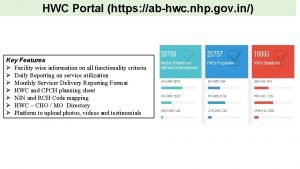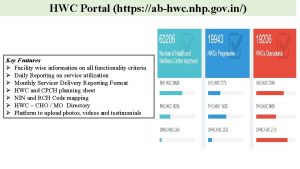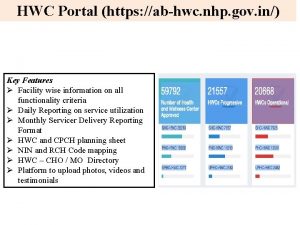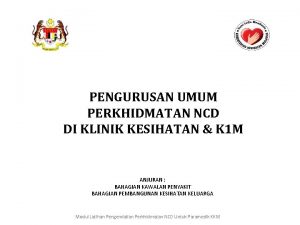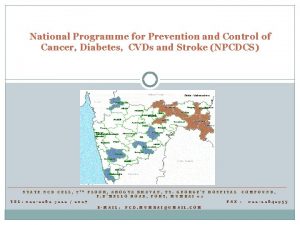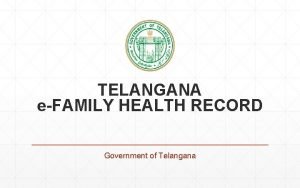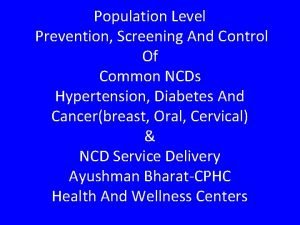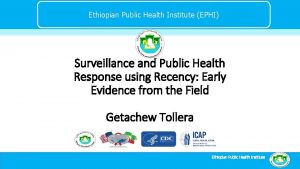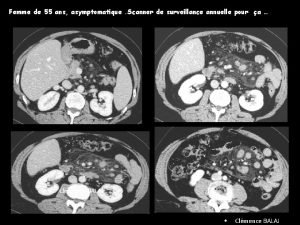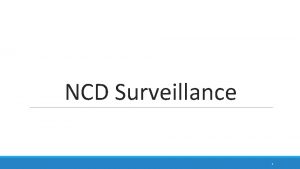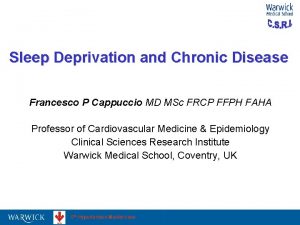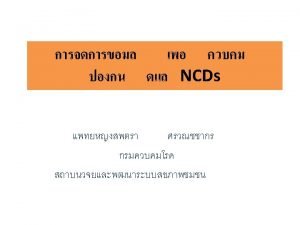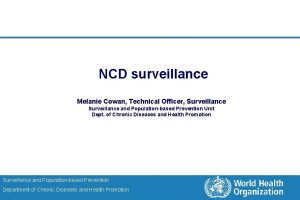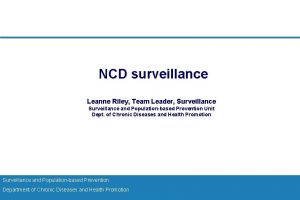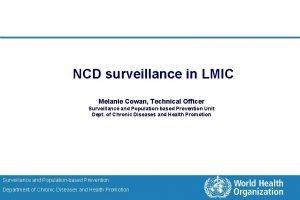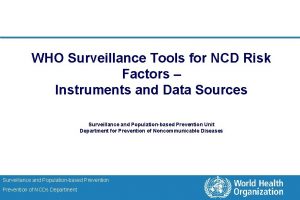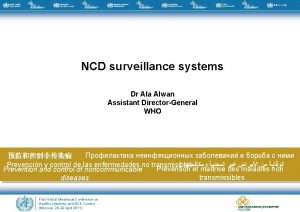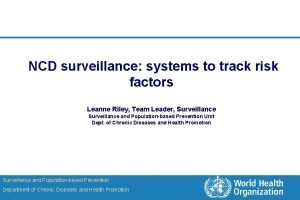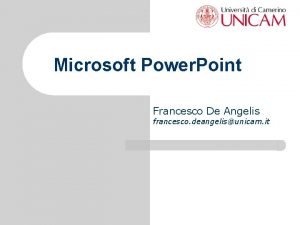Parallel session 3 NCD surveillance Francesco P Cappuccio























- Slides: 23

Parallel session 3: NCD surveillance Francesco P Cappuccio MBBS, MD MSc DLSHTM FRCP FFPH FBHS FESC FAHA Professor of Cardiovascular Medicine & Epidemiology & Consultant Physician Director, ESH Centre of Excellence Head, WHO Collaborating Centre President, British and Irish Hypertension Society University of Warwick and UHCW NHS Trust, Coventry, UK

Salt or Sodium Salt refers to sodium chloride (Na. Cl). Please note the following conversions: 2. 5 g (or 2, 500 mg) of salt = 1. 0 g (or 1, 000 mg) of sodium

Where in our diet does salt come from? In regions where most food is processed or eaten in restaurants J Am College of Nutrition. 1991; 10: 383 -93. • 12% natural content of foods • “hidden” salt: 77% from processed food – manufactured and restaurants • “conscious” salt: 11% added at the table (5%) and in cooking (6%)

A reduction in dietary salt intake reduces blood pressure nt e m ses e e gr naly a – -a y a c t n e e t m s l i s ra n s e T o v C C e R s f s o r c a Cappuccio FP. NDT 2016; 31: 1392 -6

The greater the reduction in salt intake, the greater the reduction in blood pressure Mozaffarian D et al. N Engl J Med 2014: 371: 624 -34

Stroke and Ischemic Heart Disease (CHD) as a function of Systolic BP Stroke 256 80– 89 y 128 70– 79 y Mortality* 64 60– 69 y 32 50– 59 y 16 CHD Age at risk 256 60– 69 y 32 50– 59 y 16 40– 49 y 4 4 2 2 1 1 Lewington et al. Lancet 2002; 360: 1903– 13 70– 79 y 64 8 120 140 160 180 Usual SBP (mm. Hg) 80– 89 y 128 8 0 Age at risk 0 120 140 160 180 Usual SBP (mm. Hg)

Higher salt intake predicts increased risk of stroke 7 Strazzullo P et al. BMJ 2009; 339: b 4567

‘Graded’ and ‘linear’ association between salt intake and outcomes Cardiovascular disease All-cause mortality LEFT: Cook NR et al. Circulation 2014; 129: 981 -9 RIGHT: Cook NR et al. J Am Coll Cardiol; 2016; 68: 1609 -17

Salt reduction lowers cardiovascular risk: meta-analysis of outcome trials He FJ, Mac. Gregor GA. Lancet 2011: 378: 380 -2

Absolute and proportional CV deaths attributable to sodium intake >2 g per day (salt >5 g per day) In 2010, global sodium consumption estimated at 3. 95 g per day (9. 875 g salt per day) Globally, 1. 65 m annual CV deaths attributed to sodium intake >2 g per day (>5 g salt per day) These deaths accounted for nearly 10% of CV deaths 85% of these deaths occurred in LMICs and 40% were premature (<70 years) Mozaffarian D et al. NEJM 2014: 371: 624 -34

The ‘new’ salt debate Lancet 2016; 388: 438 Is there a J-shape relationship between sodium intake and CV events? Is there any harm in reducing salt intake towards recommended targets?

Common methodological errors • Systematic errors in sodium assessment Single or incomplete 24 h urine collection Spot urine collections Dietary assessment • Reverse causality Sick populations in low sodium group • Potential for residual confounding Incomplete adjustment for confounding Incomplete follow-up • Random error in sodium assessment • Insufficient statistical power • Inconsistent results with same datasets Cobb LK et al. Circulation 2014; 129: 1173 -86

Errors in estimating usual sodium intake by the Kawasaki formula alter its relationship with mortality Bias He FJ et al. Int J Epidemiol 2018; 47: 1784 -95 Cappuccio FP et al. NMCD 2019; 29: 107 -14 Multiple 24 h urine collections Spot urine and Kawasaki

Spot urine collections inadequate to monitor changes in population salt reduction programmes Average population salt reduction (g/day) 1 0, 8 24 h Tanaka 0, 6 0, 4 0, 2 0 -0, 2 -0, 4 -0, 6 -0, 8 -1 Huang L et al. Int J Epidemiol 2018; 47: 1811 -20 Cappuccio FP et al. NMCD 2019; 29: 107 -14 Kawasaki Intersalt+K

World Health Organization Global Action Plan for NCD (2013 -2020) Salt reduction

• Voluntary vs Regulatory Cappuccio FP et al. BMJ 2010; 343: 402 -5 • Population salt intake • Urinary sodium • Dietary surveys • Reformulation progress • Salt content of foods (databanks; self-reporting by industry; market surveys) • Effectiveness of communication • Measuring awareness of campaigns • Measuring attitudes and behaviour changes Research • Setting Targets • Reformulation • Benchmarking food categories • Labelling • Industry Engagement • Motivation • Costs & Benefits • Consumer awareness • Wider support • Corporate responsibility Monitoring • Public Awareness Campaigns • Consumers • Food industry • Decision makers • Media • Health Professionals Reformulation Communication Components of a strategy to reduce population salt intake • Epidemiology • Nutrition • Public Health • Food technology • Behavioural • Evaluation • Policy

Changes in salt intake, blood pressure, stroke and IHD mortality in England from 2003 to 2011 -40% -42% Health Survey for England aged ≥ 16 years 2003 N=9183 2006 N=8762 2008 N=8974 2011 N=4753 -3. 0 mm. Hg -1. 4 g/d He FJ et al. BMJ Open 2014; 4: e 004549

Cost-effectiveness A reduction in salt intake of 3 g per day would save 194, 000392, 000 QALYs and $10 -24 b in health care costs annually in the US, i. e. a return of $6 -12 for every $ spent 1 Even modest reduction of 1 g per day would be cost saving and more cost-effective that using medications to lower blood pressure 1 Population reductions in salt intake through food reformulation from industry would be cost-saving. However, whilst ‘voluntary ‘ action by the food industry is costeffective, population health benefits could be 20 times greater with Government legislation of moderate salt limits in processed foods 2 18 1 Bibbins-Domingo 2 Cobiac K et al. NEJM 2010; 362: 590 -9 LJ et al. Heart 2010; 96: 1920 -5

Effectiveness hierarchy of dietary salt reduction policies 2, 5 2 1, 5 1 0, 5 0 -0, 5 Salt reduction (g per day) DOWNSTEAM (Agentic) UPSTREAM (Structural) 2 1, 45 0, 1 Worksite interventions -0, 5 0, 3 0, 6 0, 4 Health Education Tax and Nutrition labelling and Media Community-based Campaigns counselling -1 Hyseni L et al. PLo. S ONE 2017; 12: e 0177535 Shoort-term dietary advice 0, 7 School interventions 0, 8 Voluntary reformulation Mandatory refromulation Long-term dietary advice * * Under optimal trial conditions. ; smaller reductions anticipated in unselected individuals

Inequalities in salt reduction policies in WHO Region for Europe IHDI=Inequality-adjusted Human Development Index Rodriguez-Fernandez R et al. Public Health Nutr 2014; 17: 1894 -1904

Social inequalities in salt intake Italy Great Britain P linear<0. 001 n=2, 105 n=3, 857 P linear<0. 0001 n=1, 027 n=3, 857 Ji C et al BMJ Open 2013; 3: e 002246 Ji C & Cappuccio FP. BMJ Open 2014; 4: e 005683 Cappuccio FP et al. BMJ Open 2015; 5: e 007467

Greater reduction in low SES Policy forecast for England up to 2025: health equity and effectiveness Gillespie DOS et al. PLo. S ONE 2015; 10: e 0127927

Conclusions Salt consumption is much higher than needed High salt intake increases BP in humans A reduction in salt consumption causes a dose-dependent reduction in BP Lower salt intake is associated with lower morbidity and mortality from CVD Population salt reduction programmes are feasible and effective (preventive imperative) cost-saving in all settings (economic imperative) powerful, rapid, equitable (political imperative) life saving (moral imperative) Reduction in salt recommended for the prevention of CVD, especially stroke (WHO 30% reduction by 2025, aim <5 g per day) Global action is under way
 Abhwc app portal login
Abhwc app portal login Hwc portal data entry
Hwc portal data entry Hwc mo portal
Hwc mo portal Klinik paramedik
Klinik paramedik Ncd dh amravati
Ncd dh amravati Jhs.telangana.gov.in
Jhs.telangana.gov.in Ncd
Ncd Ncd anm login
Ncd anm login Ncd schoology
Ncd schoology Means?
Means? Example of parallel force
Example of parallel force Parallel structure def
Parallel structure def Parallel structure definition
Parallel structure definition Tiny elevation of hill like structure
Tiny elevation of hill like structure 4 bit shift register
4 bit shift register Parallelism rules
Parallelism rules Strategic control process
Strategic control process Airborne surveillance applications
Airborne surveillance applications Video surveillance system
Video surveillance system Surveillance definition
Surveillance definition Ephi ethiopia
Ephi ethiopia Signe du halo graisseux
Signe du halo graisseux Continuing analysis and surveillance system
Continuing analysis and surveillance system Disadvantages of rhino poaching
Disadvantages of rhino poaching
